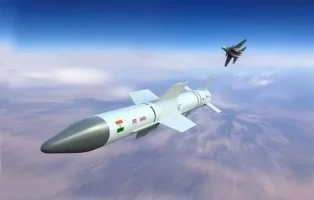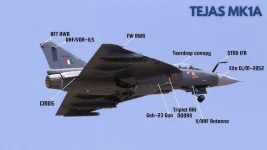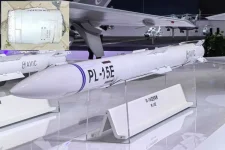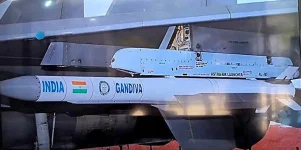- Views: 5K
- Replies: 7
India's leading defence research agency, the Defence Research and Development Organisation (DRDO), is developing a new air-to-air missile named 'Gandiva', inspired by the mythical bow of Arjuna from the Mahabharata.
This advanced missile, the Astra Mk3, is expected to significantly enhance India's air combat capabilities. Reports indicate the Gandiva, a beyond-visual-range air-to-air missile (BVRAAM), will feature a sophisticated solid fuel ducted ramjet (SFDR) engine, enabling it to hit targets over 300 kilometres away.
The missile is currently undergoing initial flight tests, known as captive trials, with plans for full production by 2030. This development aims to provide the Indian Air Force (IAF) with abilities comparable to leading international missiles, such as Europe's MBDA Meteor.
The Astra Mk3 'Gandiva' employs an advanced propulsion system called a solid fuel ducted ramjet (SFDR). This technology allows the missile to use oxygen from the atmosphere to burn its fuel, which means it doesn't need to carry its own oxidizer. This makes the missile lighter and more efficient.
The SFDR engine can also adjust its speed, allowing the Gandiva to maintain speeds of up to Mach 4.5 (4.5 times the speed of sound) over long distances.
Under ideal conditions, such as when launched from an aircraft flying at a high altitude of 20 kilometres, its range could extend to between 300 and 350 kilometres.
A key advantage of the SFDR is its ability to change thrust during flight, significantly increasing its 'no-escape zone' – the area where a target cannot evade the missile. This makes it particularly effective against agile targets like modern fighter jets and important aircraft like Airborne Warning and Control Systems (AWACS).
Compared to earlier Indian air-to-air missiles like the Astra Mk1 (with a range of 80-110 km) and the Astra Mk2 (140-160 km range) that use traditional rocket motors, the Gandiva's ramjet engine provides much greater range and maintains its energy for longer. This makes the Gandiva a "super beyond-visual-range air-to-air missile," putting it in the same league as the world's top missiles.
It is also relatively light, weighing about 220 kilograms, allowing it to be fitted on various IAF fighter jets, including the Su-30MKI, HAL Tejas, and possibly the Rafale and MiG-29 aircraft.
Recent photographs showing the Astra Mk3 attached to an Su-30MKI fighter jet suggest that captive trials – initial flight tests where the missile is carried by the aircraft without being launched – are currently underway. These trials are essential to confirm that the missile works correctly with the aircraft's electronic systems, radar, and weapon control mechanisms.
DRDO officials have stated that the missile's development is expected to be finished by the end of 2025. Further captive trials are planned to ensure it operates smoothly. After these, the missile will undergo extensive user trials with the IAF, likely lasting three to four years, before being officially introduced into service by 2030.
The SFDR engine technology, a collaborative effort between India and Russia initiated in 2013, has successfully moved past several development challenges. Ground-based tests of the SFDR have been ongoing since 2017. A significant achievement occurred in December 2024, when DRDO confirmed the proper functioning of the missile's engine, guidance systems, and flight characteristics during a ground-based launch at the Integrated Test Range in Odisha.
The ongoing flight trials with the Su-30MKI represent a crucial stage, focusing on testing the missile's active radar seeker – believed to be an Indian-developed AESA (Active Electronically Scanned Array) type – and its two-way data communication system. This data link enables the missile to receive updated target information during its flight from either the launching aircraft or an AWACS plane.
The Astra Mk3 'Gandiva' is being developed to address new and evolving aerial threats in the region. This includes challenges posed by aircraft such as China's J-20 stealth fighters and advanced missiles like the PL-15 (with a reported range of 200-300 km) operated by potential adversaries.
The Gandiva's ability to hit targets beyond 300 km and its capacity to sharply change altitude by up to 10 kilometres gives the IAF significant advantages in engaging targets from very long distances. This capability is expected to exceed that of Pakistan's AIM-120C AMRAAM missiles (105-120 km range) and the export version of China's PL-15 missile (145 km range).
Despite the significant potential of the Astra Mk3, the development of its SFDR engine has encountered delays. These are primarily due to the intricate challenges involved in making the ramjet technology small enough for an air-to-air missile.
In November 2024, a DRDO representative acknowledged that adapting this technology for missile use has taken longer than expected, meaning full-scale manufacturing is still some years in the future.
Further challenges include ensuring the missile's systems work effectively with aircraft radar, maintaining reliable data communication, and guaranteeing the seeker's accuracy at very long distances, especially when dealing with stealth aircraft or electronic interference.
Nevertheless, DRDO is making steady progress and is dedicated to surmounting these obstacles, as shown by developments like the creation of a Common Ejection Launcher (CEL) compatible with both the Astra Mk2 and the new Astra Mk3.
The research organisation is also considering two versions of the 'Gandiva'. One will be a standard model with the ramjet engine and an AESA seeker, while another could feature an additional booster to achieve even longer ranges, potentially to target crucial support aircraft like aerial refuelers.
These ongoing efforts are set to establish the 'Gandiva' as a vital component of India's air power and aerial defence capabilities by the year 2030.





